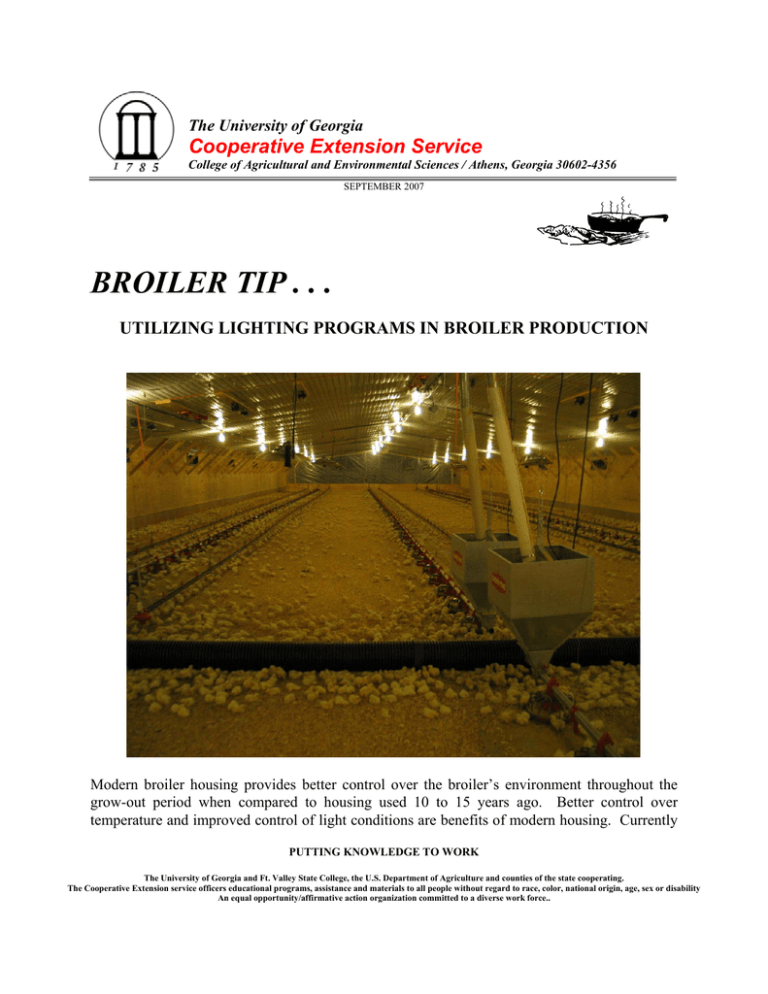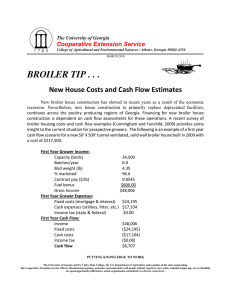BROILER TIP . . . Cooperative Extension Service The University of Georgia
advertisement

The University of Georgia Cooperative Extension Service College of Agricultural and Environmental Sciences / Athens, Georgia 30602-4356 SEPTEMBER 2007 BROILER TIP . . . UTILIZING LIGHTING PROGRAMS IN BROILER PRODUCTION Modern broiler housing provides better control over the broiler’s environment throughout the grow-out period when compared to housing used 10 to 15 years ago. Better control over temperature and improved control of light conditions are benefits of modern housing. Currently PUTTING KNOWLEDGE TO WORK The University of Georgia and Ft. Valley State College, the U.S. Department of Agriculture and counties of the state cooperating. The Cooperative Extension service officers educational programs, assistance and materials to all people without regard to race, color, national origin, age, sex or disability An equal opportunity/affirmative action organization committed to a diverse work force.. there is much interest in lighting programs for broiler production, but information on the impact that such programs have on broiler performance is limited. A few years ago, it was not uncommon to have 23 to 24 hour photoperiods. While continuous lighting resulted in maximum feed consumption it was not the best for bird performance. Spiking mortality was one particular condition that was actually found to be reduced by providing a dark period of 4 to 6 hours. As lighting programs have become more popular and utilized by the broiler industry they have become more varied. General Broiler Lighting Programs First, let’s review some information about light intensity measurement units. Foot candles (fc) are a standard light measuring unit where 1 fc = 10 lux. Lux is the metric unit for light measurement. There is no single lighting program that meets the needs of every farm, complex or even broiler breed. Table 1 is an example of a basic program showing light management trends currently used by broiler producers. Table 1. Generic lighting program that demonstrates changes in intensity and duration of light in broiler production. Day Hours of Light Intensity Comments Light:Dark 1 24:0 2.5 fc (25 lux) or greater Want as much light as possible to encourage birds to locate food and water sources 3 22:2 No change Give a small dark period so birds can get used to darkness 7 18:6 No change Increase dark period and reduce light intensity to slow growth rate allowing for growth and development of body systems before adding a 10 No change 0.5 fc (5 lux) lot of muscle 28 to 22:2 No change Increase the light period to optimize growth market and reduce bird flightiness during catching What is the Best Lighting Program? Many producers want to know what the best lighting program is for broiler production. Unfortunately that is not a straightforward answer. Broiler breed, nutrition and market age are all factors that must be considered when utilizing lighting programs. Some broiler breeds may not need any changes in light intensity while some will respond well to such changes. At this time, the best thing to do is to focus on the program recommended by the primary breeder or integrator. Providing a continuous lighting program will not provide the best bird by market age. Light intensity and duration are important components to lighting programs and should be routinely monitored. The light source and lighting system maintenance have big impact on the lumens produced. Light intensity will directly affect activity. Having good light intensity of at least 2.5 fc (25 lux) during the brooding period is crucial to good performance in the first week. Steps to optimize broiler house lighting Pick the right light source. When choosing a light bulb, the lumen output should always be considered. A lumen is how much light is produced, while wattage is the amount of power used to produce that light. In general, higher wattage bulbs will produce more lumens, but it is not always the case. Table 2 lists lumen range for several difference wattage light bulbs. In some cases the higher wattage bulbs actually produce no more or less lumens than those in the lower wattage categories. • Table 2. Incandescent wattage and lumen range. Incandescent wattage Average Lumens Lumen Range 40 408 320-495 60 695 500-890 75 1910 700-1210 100 1412 1075-1750 *See February 2004 Poultry Housing Tip for more information. http://www.engr.uga.edu/service/extension/ventilation/tips/2004/vol16n2.pdf • Pay attention to wattage. While lumens is the most important factor, it is important not to overload the system by purchasing light bulbs with too high of a wattage. Light bulb wattage should be matched with a properly sized dimmer and breaker. Putting too much wattage in a house could result in constant tripping of the breaker. • Clean light bulbs regularly. Dirt, dust and fly specs will significantly reduce light output. As a result, a dirty bulb will not emit the same amount of light as a clean light bulb. When it comes to getting chicks off to a good start every lumen counts. • Check light intensity periodically. Getting chicks off to a good start is crucial to good performance. Having a house that is too dark (less than 2.5 fc or 25lux) can result in reduced 7 day performance. The cost of a durable and accurate light meter can range from $100 to $200. When checking light intensity, the light meter should be positioned towards the brightest light source. This will depend on location in the house, fan status and possible even time of day. Read the October 2003 Poultry Housing Tip for additional information on measuring light intensity (http://www.engr.uga.edu/service/extension/ventilation/tips/2003/vol15n9.pdf). • Replace old or blown bulbs. It may sound like common sense, but something as simple as changing a blown bulb can make a big difference in bird performance. As bulbs get old their lumen output decreases, so even though those light bulbs have not blown, the house light intensity may be lower than expected. Brian D. Fairchild Extension Poultry Scientist Extension County Coordinator/Agent **Consult with your poultry company representative before making management changes.** “Your local County Extension Agent is a source of more information on this subject”





